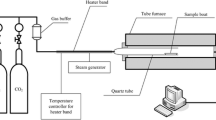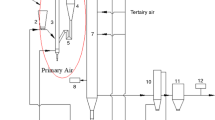Abstract
Pulverized coal reburning, ammonia injection and advanced reburning in a pilot scale drop tube furnace were investigated. Premix of petroleum gas, air and NH3 were burned in a porous gas burner to generate the needed flue gas. Four kinds of pulverized coal were fed as reburning fuel at constant, rate of 1g/min. The coal reburning process parameters including 15%~25% reburn heat input, temperature range from 1100 °C to 1400 °C and also the carbon in fly ash, coal fineness, reburn zone stoichiometric ratio, etc. were investigated. On the condition of 25% reburn heat input, maximum of 47% NO reduction with Yanzhou coal was obtained by pure coal reburning. Optimal temperature for reburning is about 1300 °C and fuel-rich stoichiometric ratio is essential; coal fineness can slightly enhance the reburning ability. The temperature window for ammonia injection is about 700°C~1100°C. CO can improve the NH3 ability at lower temperature. During advanced reburning, 72.9% NO reduction was measured. To achieve more than 70% NO reduction, Selective Non-catalytic NOx Reduction (SNCR) should need NH3/NO stoichiometric ratio larger than 5, while advanced reburning only uses common dose of ammonia as in conventional SNCR technology. Mechanism study shows the oxidization of CO can improve the decomposition of H2O, which will rich the radical pools igniting the whole reactions at lower temperatures.
Similar content being viewed by others
References
Chen, S.L., Kramlich, J.C., 1989. Optimization of reburning for advanced NOx control on Coal-fired boilers.Control Technology,39(10):1375–1379.
Chen, S.L., Lyon, R.K., 1991. Advanced non-catalytic post combusion NOx control.Environmental Progress,10(3):182–185.
Furrer, J., Deuber, H., 1998. Balance of NH3 and behavior of polychlorinated dioxins and furans in the course of the selective non-catalytic reduction of nitric oxide at the TAMARA waste incineration plant.Waste Management,18:417–422.
Glarborg, P., Miller, J.A., 1994. Modeling the thermal DENOx process in flow reactions. surface effects and nitrogen oxide formation.International Journal of Chemical Kinetics,26:421–436.
Hampartsoumian, E., Folayan, O.O., 2003. Optimisation of NOx reduction in advanced coal reburning systems and the effect of coal type.Fuel,82:373–384.
Kasuya, F., Glarborg, P., 1995. The thermal DeNOx process: influence of partial pressures and temperature.Chemical Engineering Science,50(9):1455–1466.
Liu, H., Hampartsoumian, E., Gibbs, B.M., 1997. Evaluation of the optimal fuel characteristics for efficient NO reduction by coal reburning.Fuel 76(11):985–993.
Ljungdahl, B., Larfeldt, J., 2001. Optimised NH3 injection in CFB boilers.Powder Technology,120:55–62.
Miller, J.A., Bowman, A.A., 1989. Mechanism and modeling of nitrogen chemistry in combustion.Prog Energy Combust Sci,15:287–338.
Nimmo, W., Patsias, A.A., Hampartsoumian, E., Gibbs, B.M., Fairweather, M., Williams, P.T., 2004. Calcium magnesium acetate and urea advanced reburning for NO control with simultaneous SO2 reduction.Fuel,83:1143–1150.
Priddle, R., 1998. IEA World Engery Outlook, Paris.
Radjevic, M., 1998. Reduction of nitrogen oxides in flue gases.Environmental Pollution,102(sl):685–689.
Rota, R., Zanoelo, E.F., 2000. Analysis of thermal DeNOx process at high partial pressure of reactants.Chemical Engineering Science 55:1041–1051.
Rota, R., Antos, D., 2002. Experimental and modeling analysis of the NOxOUT process.Chemical Engineering Science,57:27–38.
Smoot, L.D., 1998. NOx control through reburning.Prog Energy Combust Sci,24:385–408.
Stallings, J., 2000. Cardinal 1 Selective Non-Catalytic Reduction (SNCR) Demonstration Test Program. Report NO. 000000000001000154, EPRI, Palo, Alto, CA.
Suhlmann, J., Rotzoll, G., 1993. Experimental characterization of the influence of CO on the high-temperature reduction of NO by NH3.Fuel,72: 175–179.
Tree, D.R., Clark, A.W., 2000. Advanced reburning measurements of tempepature and species in a pulverized coal flame.Fuel,79:1687–1695.
Zamansky, V.M., 1997. Second Generation Advanced Reburning for High Efficiency NOx Control. DOE Report No. DE-AC22-95PC95251, EER Corporation.
Zamansky, V.M., Rusli, D., 1999. Reactions of sodium species in the promoted SNCR process.Combustion and Flame,117:821–831.
Zandaryaa, S., Gavasci, R., 2001. Nitrogen oxides from waste incineration: control by selective non-catalytic reduction.Chemosphere,42:491–497.
Author information
Authors and Affiliations
Corresponding author
Rights and permissions
About this article
Cite this article
Wang, Zh., Zhou, Jh., Zhang, Yw. et al. Experiment and mechanism investigation on advanced reburning for NOx reduction: influence of CO and temperature. J Zheijang Univ Sci B 6, 187–194 (2005). https://doi.org/10.1631/jzus.2005.B0187
Received:
Accepted:
Published:
Issue Date:
DOI: https://doi.org/10.1631/jzus.2005.B0187




